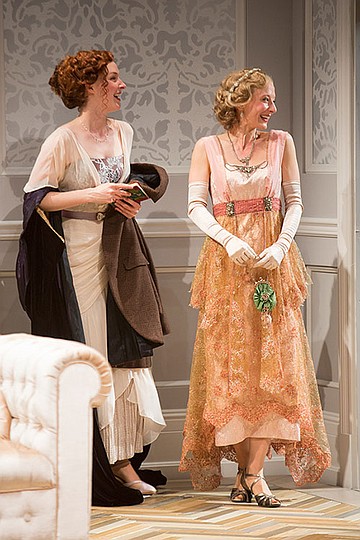 Facebook
Facebook
 X
X
 Instagram
Instagram
 TikTok
TikTok
 Youtube
Youtube

J.B. Priestley’s 1937 drama is not a great play. But it’s a haunter. The Old Globe’s excellent cast probably won’t have too many standing ovations because the spell doesn’t break until long after the curtain call.
Priestley studied time the way the faithful study religion. His coffee-table book, Man and Time, offers a guided tour through various philosophies on the subject, and, in part two, a “Dream Bank” of personal accounts: ESP, glimpses of the past and “precognitive warnings” of the future.
Priestley says there are kinds of time. One is linear, clock-time that moves forward. The other partakes of synchronicity; everything happens at once.
Thornton Wilder uses the latter in The Skin of Our Teeth, where the Antrobus family finds themselves in the Ice Age and, later, have a dinosaur in the sitting room.
Time and the Conways presents both. It begins in 1919, just after the “war to end all wars” ended. It’s back-stage at Kay’s 21st birthday party. The five Conway sisters and brother Alan don goofy costumes and play charades — which they pronounce “sha-rods” — in their elegant villa in Newlingham, England.

Though some, like Kay and young Carol, utter Dream Bank premonitions, hopes are fresh. Courtships abound. Love is in the air.
The Globe actors perform on Neil Patel’s sleek, stark-white, box set (typical of the period). At the end of Act one, the set recedes, like Time itself. And a second set, a mirror of the first, only older and more tattered, appears on a mini-thrust stage.
Nineteen years have passed. Kay is now 40 and not the novelist she aspired to be. World War II is just around the corner.
The set for Act one remains in the background, like a parallel universe or an emblem of “synchronic” time. Soon it becomes clear why young ebullient Carol lies on the 1919 couch.
In 1938, the Conways’ aspirations have declined, but in different ways. Joan, Hazel, and Hazel’s gravel-hearted husband Ernest should have been more careful what they wished for. Stately, egocentric Mrs. Conway and favorite son Robin frittered away their inheritance and face the consequences. And “dull,” stuttering Alan’s a philosopher.
Act three harkens back to 1919. The party’s almost over. With subtle links, sly hints, and the hindsight gained from Act two, Priestly reveals the seeds of disillusion in the dreamers’ wishes.
The characters are sketchily drawn: they are this way; they are that way; they are this/that way. Along with Patel’s terrific set, the production’s other standout is director Rebecca Taichman. She creates fluid movement, gracefully sculpted blockings, and deft Chekhovian nuances - someone mentions money just as Hazel dons a fur coat; subtle hand gestures; sudden glances – that speak visual volumes.
Shakespeare called Time “envious and calumniating” and a “great-sized monster of ingratitudes.” So do most of Priestley’s characters as they move forward.
But maybe it isn’t, as Alan says, not if you see the big, synchronic picture.


J.B. Priestley’s 1937 drama is not a great play. But it’s a haunter. The Old Globe’s excellent cast probably won’t have too many standing ovations because the spell doesn’t break until long after the curtain call.
Priestley studied time the way the faithful study religion. His coffee-table book, Man and Time, offers a guided tour through various philosophies on the subject, and, in part two, a “Dream Bank” of personal accounts: ESP, glimpses of the past and “precognitive warnings” of the future.
Priestley says there are kinds of time. One is linear, clock-time that moves forward. The other partakes of synchronicity; everything happens at once.
Thornton Wilder uses the latter in The Skin of Our Teeth, where the Antrobus family finds themselves in the Ice Age and, later, have a dinosaur in the sitting room.
Time and the Conways presents both. It begins in 1919, just after the “war to end all wars” ended. It’s back-stage at Kay’s 21st birthday party. The five Conway sisters and brother Alan don goofy costumes and play charades — which they pronounce “sha-rods” — in their elegant villa in Newlingham, England.

Though some, like Kay and young Carol, utter Dream Bank premonitions, hopes are fresh. Courtships abound. Love is in the air.
The Globe actors perform on Neil Patel’s sleek, stark-white, box set (typical of the period). At the end of Act one, the set recedes, like Time itself. And a second set, a mirror of the first, only older and more tattered, appears on a mini-thrust stage.
Nineteen years have passed. Kay is now 40 and not the novelist she aspired to be. World War II is just around the corner.
The set for Act one remains in the background, like a parallel universe or an emblem of “synchronic” time. Soon it becomes clear why young ebullient Carol lies on the 1919 couch.
In 1938, the Conways’ aspirations have declined, but in different ways. Joan, Hazel, and Hazel’s gravel-hearted husband Ernest should have been more careful what they wished for. Stately, egocentric Mrs. Conway and favorite son Robin frittered away their inheritance and face the consequences. And “dull,” stuttering Alan’s a philosopher.
Act three harkens back to 1919. The party’s almost over. With subtle links, sly hints, and the hindsight gained from Act two, Priestly reveals the seeds of disillusion in the dreamers’ wishes.
The characters are sketchily drawn: they are this way; they are that way; they are this/that way. Along with Patel’s terrific set, the production’s other standout is director Rebecca Taichman. She creates fluid movement, gracefully sculpted blockings, and deft Chekhovian nuances - someone mentions money just as Hazel dons a fur coat; subtle hand gestures; sudden glances – that speak visual volumes.
Shakespeare called Time “envious and calumniating” and a “great-sized monster of ingratitudes.” So do most of Priestley’s characters as they move forward.
But maybe it isn’t, as Alan says, not if you see the big, synchronic picture.
Comments